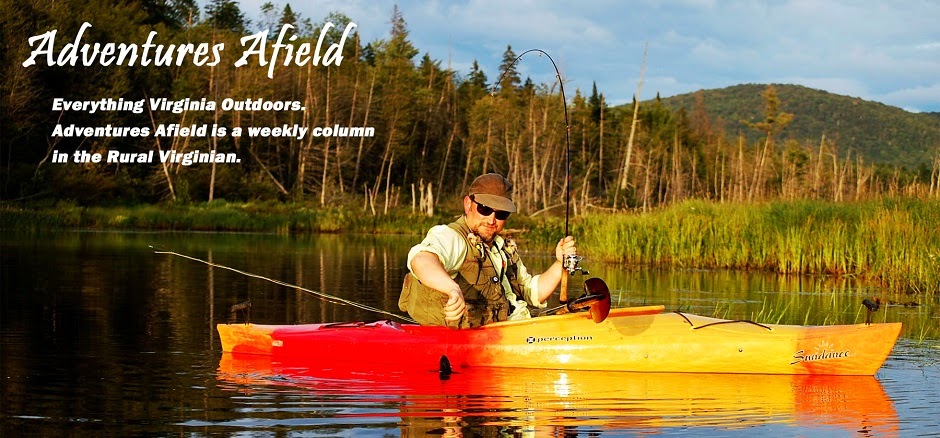The outdoor lifestyle is
ruled by the seasons, and the seasons by traditions. There is no tradition that enraptures me more
than spring on a native brook trout stream.
 |
| A sprightly Virginia brook trout. Photo by Matt Reilly |
Trout do, on occasion,
live in ugly places, despite the popular sentiment. Sewage-contaminated rivers and spillways
thick with ground up baitfish and full of big brown trout come to mind. Brook trout, however, do not—at least in my
experience.
Their necessary
fondness for clean, healthy, and cold water predetermines for them a life in
the Appalachian Mountain streams, where they serve as groundskeepers of natural
beauty and ecological vitality. Their
absence from such streams is a sure sign of a declining environment. They are a product of their surroundings; and
so it is no wonder that they are the most beautiful of fish.
In the dead of winter,
when trees lie dormant, the ground hardens, the air chews at your extremities,
and the vibrant color of a mountain empire is a faint memory tumbling somewhere
downstream, brook trout hold fast to the pigments of God’s generous paintbrush
from the bottom of the streambed. Life
resides within the river.
As spring arrives, the
air livens and color springs from water.
Dogwood, redbud, rhododendron, magnolia, mountain laurel, trillium, bluebell,
and bloodroot take over the understory, accented by the faint green of budding
hardwoods. Grass, mountain daisies, and
ferns cover the sunlit stream banks as the water warms. Insects hatch and embark on their life’s
journey; the brook trout become more active.
 |
| Mountain Daisies. Photo by Matt Reilly. |
Anglers from Shenandoah,
the Blue Ridge, and all over dream of these first signs of spring. For spring is a strong emotion in the
mountains—a sharp contrast to the doldrums of winter.
It is during the spring
months that brook trout will readily take a well-presented dry fly, and it is
perhaps experiencing the combination of such pleasant purity and the
overbearing gamut of hues and aromas present in the mountain landscape,
culminated in the brilliant flanks of a quivering trout, that so accurately
summarizes our reason for being anglers in the first place. It is, at least, why I declare the beginning
of the year on a brook trout stream. I
hold few stereotypes, but I can safely assume that where there are brook trout
is home to me.
Those with brookie
fever are many, varied, and seemingly unlikely.
It is no secret that
brook trout are a small quarry. Three
and four weight fly rods are common tools.
Streams are often just a few feet wide, and the fish rarely exceed 10
inches in length, though there is the ever-alluring opportunity for fish in
excess of 12 inches.
Regardless, it is
mostly true that anyone with an inkling of Appalachian heritage has a fondness
for the sprightly brook trout. Even the
most dedicated of big fish nuts can find excitement in the fish, both for the
challenge and the opportunity.
Though they are not
especially selective feeders, brook trout are renowned proponents of the old
Reverend Maclean’s philosophy on fishing, allowing no person lacking the
particular set of skills required to catch them to do so.
These skills
include--first and foremost--stealth.
The vast majority of brook trout streams are skinny, clear, and full of
pockets of water holding several fish.
Keeping a low profile, minimizing false casts, maintaining drag-free
drifts, and walking softly are necessary skills. Successful brook trout fishermen are bona
fide Blue Ridge ninjas first, anglers second.
 |
| Approaching the fish from behind a boulder shield. Photo by Matt Reilly. |
The typical brookie
fisherman spends more money on flies and tippet material over the course of the
first two months of spring than the total worth of his or her own rod. The tightness of cover and challenge of presentation
is just another aspect of small stream fishing that adds to the fun. There are no official testaments to my
sanity, but I have often caught myself (on a good day) chuckling when my fly
wraps around a limb on my last false cast.
Gas and energy are
equally expended resources. For the small
trout, a dedicated angler’s vehicle is stocked with marked gazetteers and
guidebooks detailing even the smallest of mountain trickles, and the “good”
fishing often doesn’t start before at least a half-hour hike upstream over
rugged terrain.
 |
| Wild, beautiful fish in a wilderness setting is the essence of brook trout fishing. Photo by Matt Reilly. |
Brookie fever is an
affliction difficult to justify or explain except by the emotions experienced
in the act of discovering it. Such an
unlikely target is the drive behind hundreds of miles of anxiously explored
dirt roads; miles of rough mountain hollows navigated on foot; countless
around-the-next-bend expeditions; and bruises, skinned knees, stubbed toes,
thorn bushes, and mosquito bites sustained.
It is the focal point of our momentary distraction from civilization,
and the medium through which we comprehend the grace of the natural world as it
was meant to be.





.jpg)
.jpg)
.jpg)